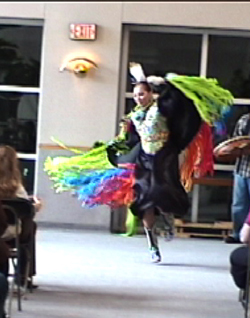 |
Jocy Bird, a member of the American Indian Dance Theater, performs in the Durham Outpatient Center’s West Atrium on Tuesday. The dance troupe’s performance was part of a series of events connected to tonight’s premiere of Opera Omaha’s “Wakonda’s Dream.” |
During a noontime performance, members of the American Indian Dance Theater performed several routines, including one that involved about 20 members of the audience participating in a dance resembling a conga line.
Among the audience members to participate in the group dance was Jessica Brummer, special events coordinator in the UNMC public affairs department.
“It was a unique experience,” Brummer said. “I was glad to be a part of it.”
The dance troupe is in town to perform in the Opera Omaha presentation, “Wakonda’s Dream,” which makes its world premiere tonight at the Orpheum Theater.
Dance is a way for American Indians to connect with their heritage and their spirituality, said troupe member Dallin Maybee. Dance performances also have a more pragmatic, but no less important effect on the performers, he said.
“One of the most basic reasons I do them is they make me feel good,” Maybee said.
Maybee was joined Tuesday by fellow dancers Jocy Bird and Sam Bearpaw as they danced to music performed by singer/drummer Adrian Cross.
|
|
The campus performance was part of a series of events related the opera’s premiere. Another event will be at noon Thursday in the atrium when the opera’s composer, Anthony Davis speaks about creating “Wakonda’s Dream” and performs on the piano.
“Wakonda’s Dream,” which will run tonight, Friday and Sunday at the Orpheum, focuses on a modern-day American Indian family and how they were affected physically, emotionally and spiritually by events that occurred in Nebraska in late 1800s concerning the legendary American Indian figure, Chief Standing Bear.
Standing Bear was detained along with 13 fellow members of his tribe for coming back to Nebraska in 1877 after being sent to Oklahoma’s “Indian Territory.” Standing Bear’s detainment was later deemed unlawful by a federal judge, who ruled that “Indians are human beings under the law” and entitled to all human rights. The case was a landmark moment for American Indian civil rights.